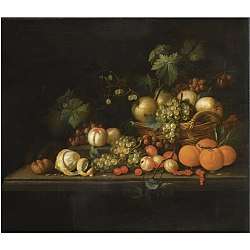Pseudo-Simons

Pseudo-Simons (fl 1650 - 1680) is the notname given to a still life painter presumed to have been active in Antwerp and to whom are attributed about 100 works, principally of fruit and flower still lifes and pronkstillevens.[1]
Identification of the artist

The notname of this artist was given by Fred Meijer of the Netherlands Institute for Art History after he grouped a body of about 100 works he considered to be by the same hand. These works had during the 20th century been attributed to the Dutch still life painter Michiel Simons (active 1648-1673). This earlier attribution to Michiel Simons was based on the view that the style of the artist was close to that of Jan Davidszoon de Heem, Ambrosius Bosschaert II and Johannes Bosschaert II. These three artists, like Michiel Simons, were from, or had worked in, Utrecht.[2]
Fred Meijer found that the style was in fact closer to that of Flemish still life painters of the second half of the 17th century such as Jan Pauwel Gillemans the Elder and Jan Pauwel Gillemans the Younger and that the artist must have must have been familiar with their work. The artist was then given a notname based on the earlier erroneous attribution to Michiel Simons and his nationality was changed from Dutch to Flemish.[3]
It is believed that this anonymous artist worked in Antwerp some time between 1650 and 1680. He may have resided and worked in England, which would account for the presence of his works in English collections already from an early date.[1]
Work

About 100 works have been attributed to the Pseudo-Simons.[4] None of the works are signed.[2] These works are principally fruit still lifes, and some flower still lifes and pronkstillevens (i.e. sumptuous still lifes of luxurious objects).[1]
His still lifes typically depict the same or similar objects in different combinations, such as a flower piece together with a fruit bowl and a lobster, often combined with birds or squirrels.[5] His style and subjects show the influence of the late 17th century still life painters Jan Pauwel Gillemans the Elder and Jan Pauwel Gillemans the Younger of Antwerp.[2]
References
- 1 2 3 Pseudo-Simons at the Netherlands Institute for Art History (in Dutch)
- 1 2 3 Pseudo-Simons, A fruit still life on a stone ledge at Jean Moust
- ↑ Pseudo-Simons, A lobster, a crab on a pewter plate, a bunch of grapes and a fig in a tazza at Christie's
- ↑ Pseudo-Simons, Still-life of Fruit and Flowers with a Parrot on a Table at the National Inventory of European Paintings
- ↑ Pseudo-Simons, Apples and grapes in a wan-li kraakware dish, with tulips, roses, irises and other flowers in a glass vase, a peeled lemon on a silver salver along with oranges, cherries and walnuts on a draped table at Bonhams
External links
